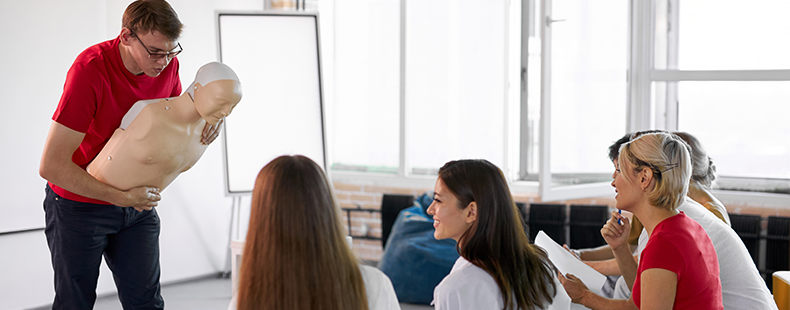First aid is the primary and instant care given to an injured or ill person before any professional medical help arrives on the spot. Educators need to have first aid skills because they are responsible for the safety and well-being of their students. In this blog post, we will discuss the importance of first aid for schools and some of the most important first aid skills that every educator should have.
Educators can take First Aid and CPR online training courses and certification from Learntastic. We have online certification programs designed specifically for educators. These online courses are flexible to learn as they can be done from anywhere. Our courses are comprehensive and comply with the latest ECC guidelines and help you earn CE points as well. Enroll now and be a smart educator!
Read More: CPR Best Practices for Physicians and Nursing Staff
Dealing with Common Injuries and Accidents in School Settings
Schools are a safe place where children come to learn and grow. However, accidents can occur anywhere and schools are not an exception. The most common injuries that occur in schools are fractures, sprains, cuts, and bruises. To prevent these injuries from happening, teachers should keep classrooms free of clutter that can cause trips and falls. Rubber mats should be used under rugs to prevent slips.
In addition, schools should have a first aid kit on hand at all times. The kit should contain bandages, gauze pads, antiseptic wipes, and other items that can be used to treat minor injuries. Teachers should also be trained in basic first aid so that they can provide immediate care to students who are injured. Educators should be prepared to deal with common injuries and accidents that can occur in school settings.
Here are some of the most important first aid skills every school staff should have:
Cardiopulmonary Resuscitation (CPR): CPR is the fallback protocol for any emergency. CPR helps in cases of sudden cardiac arrests.
Management of choking: This involves clearing a blocked airway. Younger children are susceptible to choking. Having immediate help around can help them in keeping safe.
Management of a suspected spinal/head injury: This requires immobilizing the patient and preventing further damage. These kinds of injuries can happen in the case of kids who are active in sports.
Correct administration of an EpiPen or ANAPEN: This can save the life of someone with a severe allergic reaction. Knowing how to administer it correctly can save a child from grave danger.
Management of bleeding: This involves applying pressure and dressing to the wound. Applying the right pressure and using the correct method for putting a bandage on the wound can stop it from becoming serious.
Communication skills/interpersonal ability: These are essential for dealing with people in distress and getting help.
Confidence: When you know what to do, this allows you to act decisively and calmly.
Ability to work under pressure: People can make mistakes under pressure. When you can handle pressure, you can cope with stressful and urgent situations.
Attention to detail: This ensures you follow the correct procedures and protocols.
Teamwork & leadership: These enable you to work with others and take charge when needed.
Providing CPR and AED Support in Educational Institutions
Cardiopulmonary resuscitation (CPR) and automated external defibrillator (AED) support can save lives in the event of a cardiac emergency. Schools need to have a CPR-AED program along with a group of individuals trained to do CPR and use an AED. All schools should have a cardiac emergency response plan (CERP) and all students should learn CPR and AED use before graduation.
Awareness of the importance of CPR must be raised in early childhood education. CPR training promotes a safety culture in schools. It also shifts the responsibility from adults to children. It could result in long-term structural changes. The inclusion of CPR training in schools has been encouraged by the WHO.
Conclusion
Learn First Aid from Learntastic as knowing first aid skills are essential for educators. They are responsible for the safety and well-being of their students. Educators should be prepared to deal with common injuries and accidents that can occur in school settings, as well as provide CPR and AED support when necessary. By having these skills, educators can help ensure that their students receive the immediate care they need in case of an emergency.




